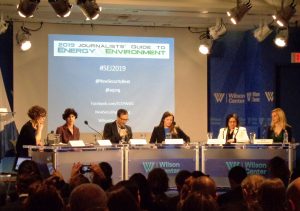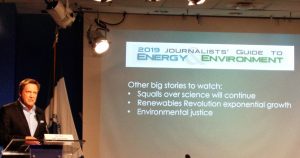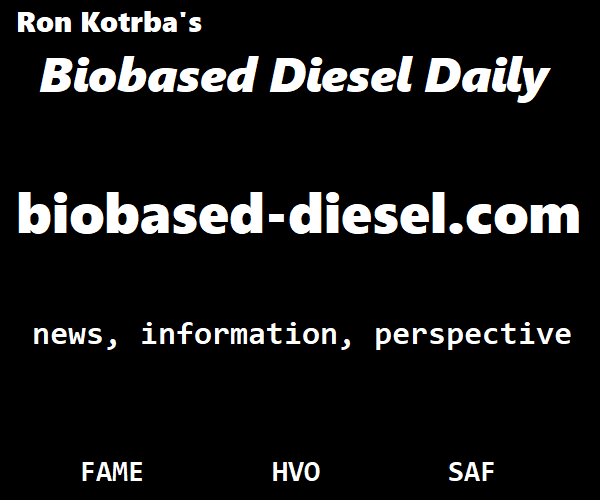by Joanne Ivancic* (Advanced Biofuels USA) Billed as the “2019 Journalists’ Guide to Energy & Environment,” the Society of Environmental Journalists held their annual presentation on Energy and Environmental Journalism January 25 at the Wilson Center in Washington, DC. The event featured an interview of U.S. Environmental Protection Agency Assistant Administrator for Air William Wehrum by The Guardian’s Emily Holden, followed by a journalists’ panel discussion. The event demonstrated what’s wrong, dissatisfying and incomplete about coverage of climate change causes, effects and policies.
William Wehrum, U.S. Environmental Protection Agency Assistant Administrator for Air
After investing a large portion of the interview badgering Wehrum about his already-known views of climate change, and failing to get him to promise to make climate change a key focus at EPA, little time remained for Holden to delve into Wehrum’s true plans for his EPA activities, to get him to identify any of his specific initiatives related to environmental regulations or to assess their intended impact on air or water quality or other environmental concerns. Unfortunately, no question was raised about the petroleum industry lobbyist who apparently escorted Wehrum to this event, either.
Journalists' Panel Discussion
Next, journalists played pundit about their take on high profile environmental issues and talked about their latest travel assignments, except for Associated Press's Christina Larson who focused on process and practices related to reporting from China and other overseas locations.
One questioner lamented that the discussion didn’t address the business, practices or elements of journalism specifically related to covering climate change. But the moderator and panel didn’t quite understand the intent of the comment so she tried to address it by asking each panelist to reflect on the question and provide a statement.
The Washington Post’s Juliet Eilperin staunchly defended what she took to be a criticism of journalism of climate change in general (rather than a criticism of the focus of the panel) and vehemently defended coverage noting that she thought their coverage was of high quality.
 SEJ panel from left Emily Holden (moderator), Juliet Eilperin, Eric Lipton, Ellen M. Gilmer, Pradny Joshi, Christina Larson.
SEJ panel from left Emily Holden (moderator), Juliet Eilperin, Eric Lipton, Ellen M. Gilmer, Pradny Joshi, Christina Larson.
Eilperin was joined by Eric Lipton of The New York Times who noted that paper is hiring another reporter to cover the topic. He did allow that reporters should get out into the world to do on-location reporting more often, describing the horrible air pollution he experienced firsthand during a recent trip to the Bakken oil/gas fracking fields. Apparently, getting reporters into the environments they write about is a big, difficult deal; not routine. I would have liked to hear more about how these leaders in journalism intended to change that—or if they think that’s the appropriate way to cover these topics.
Particularly lacking in providing a sophisticated picture of issues or coverage of climate change in the agricultural sector was Politico’s Agriculture and Trade editor, Pradnya “P.J.” Joshi. She was great when talking about international trade agreements; but could only think of Farm Bill fights about conservation land between environmentalists and agriculture interests when asked how climate change impacted agriculture.
Although she also mentioned weather issues of drought and floods, she never mentioned lengthening growing seasons or crops that can be grown further north than they could 20-50 years ago. Or pests or diseases that are cropping up in new places and the difficulties and innovations related to fighting them. Or the pressure on land owners to convert quality agricultural land to solar fields and related land use change or indirect land use change issues.
Of equal concern, Joshi completely missed noting that agriculture supplies 10% of US ground transportation fuel, lessening not only life cycle greenhouse gas emissions, but reducing air pollution in other ways, as well. She noted that farmers are trying to lessen their carbon footprint by using drones and reducing use of diesel-powered farm equipment, but never mentioned the possibility of using renewable fuels in farm equipment. She failed to characterize any of that as part of “climate smart agriculture” or to note experiments to quantify carbon sequestration by crops.
Although she covered dairy news early in her career, agriculture is obviously not her current area of expertise and she probably should not have been on the panel representing coverage of climate change in an agricultural context. Or, perhaps she is representative. And that might explain why there’s little understanding of the suffering agriculture experiences due to climate change, the changes in farming crops and practices that will occur to adapt to climate change, and the positive role agriculture can have in mitigating climate change.
Larson, the Global Science & Environment Correspondent for the Associate Press, gave some of the most telling insights. In particular, Larson talked about covering climate change around the world, particularly in Asia, and most specifically in China. When asked to make a comparison, she talked about the personal discomfort and health risks attendant on covering the environment in a country where the air pollution is so bad that you calculate each day how many face masks you’ll need when you go out the door. Compared to those conditions, although the US has serious issues about safe drinking water and other environmental problems, she reminded us that this country is far ahead of much of the world in what we have done to assure clean air and water.
Holden, who moderated the panel, never raised the issue of carbon price/cost/tax in any guise (tax-and-dividend; cap-and-trade; carbon user fee) although legislation has been introduced on Capitol Hill, has been identified by many economists as the only way to achieve change in a market-based economy, and many believe that without some kind of supportive policy like a carbon tax or low carbon fuel standard that nothing adequately significant will happen to change the way we make and use energy.
Suggestions to Remedy these Problems with Climate, Energy and Environmental Journalism
From observing this discussion among some of the senior journalists in the environmental space working at some of the most respected news organizations in the US, it appears that a new approach to the multi-faceted subject of climate change and environmental reporting is needed.
All panelists acknowledged at some point the overlapping subject areas. They also acknowledged that many see environmental reporters as on the “side of environmentalists.” Probably, the journalists argued, because they base their reporting on science warning of the changes coming due to global climate change.
 SEJ board member, Jeff Burnside, reviews the 2019 Guide and its list of numerous important energy and environment topics.
SEJ board member, Jeff Burnside, reviews the 2019 Guide and its list of numerous important energy and environment topics.
I’d like to see next year’s panel talk about new and improved ways to cover this difficult multifaceted area. Maybe if reporters didn’t see themselves as arbitrators, trying to show “both sides,” but as mediators trying to help the public and those with multiple perspectives and interests to understand each others’ perspectives and interests and to then analyze where there are common goals, where the resources are to reach those goals, environmental journalism could improve. Then, journalists wouldn’t be seen as “on the side of environmentalists” and maybe even “environmentalism” could achieve a more realistic meaning.
The old adage, “Follow the Money” might also reveal the power struggles, both political and economic and should have a place in climate, energy and environmental journalism.
Coverage might also benefit from collaborative reporting with those who understand Wall Street and how/why it invests along with experts in the various sciences of climate change (from climate and weather modelling to the elements of the carbon cycle; from biologists, ecologists, engineers and agronomists to automotive and engines/fuels experts); with those knowledgeable of federal, state, regional and local agencies tasked with work that impacts climate change positively or negatively; with lawyers who can explain regulations and litigation; and those who can track down the financing pushing particular perspectives, studies, policies.
This will result in a far more robust picture of not only the problems and opportunities resulting from climate change, but also of the human elements causing, enabling, fighting or taking advantage of them.
I’d also like to hear a discussion about editorial pressure on journalists related to ad purchases, news outlet ownership, the need to attract clicks or eyes, the amount of funding for lengthy investigative reporting and other business elements that might influence how climate change is covered.
I’d like to hear how journalism schools could address the difficulties of environmental reporting, how to make it interesting without overhyping, patronizing or sensationalizing. With the Green New Deal and serious climate, energy and environmental legislation and regulation anticipated in the coming years, journalists will be relied on for quality, knowledgeable, insightful and objective information.
Why not weekly in-depth shows about the environment on all the key broadcast and cable news channels? The weather channel used to be an excellent source for climate change information. That programming should return. Newspapers should have dedicated expert op-ed columnists focused on environmental issues.
Reaction to Presentation
Everyone I spoke with at the reception after the presentations, except for organizers and speakers, expressed disappointment about the presentation.
One person said the reporters acted more like pundits on their area of expertise rather than as journalists doing a constructive critique of their work, business and industry with an eye to improvement. A comment in line with the person who submitted the question lamenting the lack of expected analysis of climate journalism from the panel.
I believe the Society for Environmental Journalists can do better than this to advocate for and deliver true quality, objective coverage of an enormously complex world of topics.
Prominent Reporters See Critical Year Ahead on Energy, Environment (Society of Environmental Journalists)
View a slideshow of images from the event | Watch the full webcast
*Joanne Ivancic serves as executive director of Advanced Biofuels USA.
Related articles:
Why covering the environment is one of the most dangerous beats in journalism http://theconversation.com/why-covering-the-environment-is-one-of-the-most-dangerous-beats-in-journalism-105477
There’s finally an increase in environmental journalism, but it’s inconsistent. Here’s how to fix that 2015 https://www.cjr.org/analysis/environmental_coverage_consistency.php
“The Need for Environmental Journalism Is More Acute Now Than Ever” The Revelator speaks with Bobby Magill, president of the Society of Environmental Journalists. 2017 June https://therevelator.org/environmental-journalism/
EPA regulator skirts the line between former clients and current job (Washington Post)
PS: This is the kind of environmental writing we need more of; with in-depth follow-up on what are the options; policies, financing, other crops, etc.: Ruined crops, salty soil: How rising seas are poisoning North Carolina’s farmland (Washington Post)
Fighting Climate Change Is Much More Than Just Hugging Trees (Our Daily Planet)
House panel launches probe of EPA’s air policy chief (Washington Post)
EPA, DEMS FIGHT OVER WEHRUM-INDUSTRY TIES: (Politico's Morning Energy)
Excerpt from Our Daily Planet: But far more disheartening was the reaction from the “liberal” media. The entire lineup of MSNBC anchors was anxious to discuss and dismiss climate change as a fluffy, feel-good issue and hardly “meaty” enough to build a campaign around. They seem to have forgotten all the news lately – the news that they read and report on a daily basis. How about the fact that the Black Friday Report on Climate Change dropped this bombshell – climate change has cost the U.S. economy $350 billion over the past decade. Or the fact that NOAA reported that in 2018, there were 14 weather and climate disasters that cost a billion dollars or more and these resulted in a total of $91 billion in damages. Or that our military and intelligence leaders consider climate change a top national security threat – even if the President is trying to rewrite that assessment with a bunch of non-experts from the White House. Or that experts estimate (using EPA’s own statistics) that regulatory rollbacks, such as the clean car rule and the clean power plan, will cause thousands of premature deaths while leaving these rules in place would actually save $90 billion annually in human health costs.
A friend of ours wrote us and asked point blank “Is Inslee’s campaign dead on arrival because it’s focusing on one issue?” Inslee’s campaign will face an uphill battle because he is unknown outside of his home state of Washington. But if anything, centering his campaign on climate change will give him an important plank – one that is a rallying cry for many on the left, just as building a border wall was for Trump supporters in 2016.
However, climate change as a political issue is also much more significant than even most Democrats give it credit for. It encompasses literally every other voting priority like jobs, economy, national security, healthcare, immigration, etc., etc. Dems have just never communicated it as such. It can provide a unifying framework on which to hang many popular proposals. It can give the Democrats a platform that holds together thematically – and that is easy to communicate. It is a much better vehicle to engage the public than a bunch of policy memos and wonky ideas that none of these candidates could make appealing.
Climate change, and its government response – the Green New Deal – is big and bold and will make us great again by moving the nation forward, rather taking us back. Much like its namesake, President Franklin Roosevelt’s New Deal, there’s something for everyone. It is about the economy, an energy revolution, national security, agriculture, immigration, public health, and enjoying the outdoors. It is about making every sector of our economy work more efficiently and cost us less – pollution is nothing more than waste that someone else has to pay for – either through illness or blight or ravaging fires or storms. Corporate polluters have been given tax cuts for decades and regulatory rollbacks will cost millions of American lives. They’ve also been responsible for spreading climate denial and perpetuating the false narrative that action on climate comes at the direct cost of the economy. It’s time that the health and safety of the American public are prioritized over the profits of fossil fuel companies.
So bring it on, Governor Inslee. Keep talking about climate change. We need it. And maybe if you keep it up, even the Democrats will see it for what it is – the fuel for a blue wave in 2020. READ MORE
Nearly 55,000 articles in our online library!
Use the categories and tags listed below to access the nearly 50,000 articles indexed on this website.
Advanced Biofuels USA Policy Statements and Handouts!
- For Kids: Carbon Cycle Puzzle Page
- Why Ethanol? Why E85?
- Just A Minute 3-5 Minute Educational Videos
- 30/30 Online Presentations
- “Disappearing” Carbon Tax for Non-Renewable Fuels
- What’s the Difference between Biodiesel and Renewable (Green) Diesel? 2020 revision
- How to De-Fossilize Your Fleet: Suggestions for Fleet Managers Working on Sustainability Programs
- New Engine Technologies Could Produce Similar Mileage for All Ethanol Fuel Mixtures
- Action Plan for a Sustainable Advanced Biofuel Economy
- The Interaction of the Clean Air Act, California’s CAA Waiver, Corporate Average Fuel Economy Standards, Renewable Fuel Standards and California’s Low Carbon Fuel Standard
- Latest Data on Fuel Mileage and GHG Benefits of E30
- What Can I Do?
Donate
DonateARCHIVES
- July 2025
- June 2025
- May 2025
- April 2025
- March 2025
- February 2025
- January 2025
- December 2024
- November 2024
- October 2024
- September 2024
- August 2024
- July 2024
- June 2024
- May 2024
- April 2024
- March 2024
- February 2024
- January 2024
- December 2023
- November 2023
- October 2023
- September 2023
- August 2023
- July 2023
- June 2023
- May 2023
- April 2023
- March 2023
- February 2023
- January 2023
- December 2022
- November 2022
- October 2022
- September 2022
- August 2022
- July 2022
- June 2022
- May 2022
- April 2022
- March 2022
- February 2022
- January 2022
- December 2021
- November 2021
- October 2021
- September 2021
- August 2021
- July 2021
- June 2021
- May 2021
- April 2021
- March 2021
- February 2021
- January 2021
- December 2020
- November 2020
- October 2020
- September 2020
- August 2020
- July 2020
- June 2020
- May 2020
- April 2020
- March 2020
- February 2020
- January 2020
- December 2019
- November 2019
- October 2019
- September 2019
- August 2019
- July 2019
- June 2019
- May 2019
- April 2019
- March 2019
- February 2019
- January 2019
- December 2018
- November 2018
- October 2018
- September 2018
- August 2018
- July 2018
- June 2018
- May 2018
- April 2018
- March 2018
- February 2018
- January 2018
- December 2017
- November 2017
- October 2017
- September 2017
- August 2017
- July 2017
- June 2017
- May 2017
- April 2017
- March 2017
- February 2017
- January 2017
- December 2016
- November 2016
- October 2016
- September 2016
- August 2016
- July 2016
- June 2016
- May 2016
- April 2016
- March 2016
- February 2016
- January 2016
- December 2015
- November 2015
- October 2015
- September 2015
- August 2015
- July 2015
- June 2015
- May 2015
- April 2015
- March 2015
- February 2015
- January 2015
- December 2014
- November 2014
- October 2014
- September 2014
- August 2014
- July 2014
- June 2014
- May 2014
- April 2014
- March 2014
- February 2014
- January 2014
- December 2013
- November 2013
- October 2013
- September 2013
- August 2013
- July 2013
- June 2013
- May 2013
- April 2013
- March 2013
- February 2013
- January 2013
- December 2012
- November 2012
- October 2012
- September 2012
- August 2012
- July 2012
- June 2012
- May 2012
- April 2012
- March 2012
- February 2012
- January 2012
- December 2011
- November 2011
- October 2011
- September 2011
- August 2011
- July 2011
- June 2011
- May 2011
- April 2011
- March 2011
- February 2011
- January 2011
- December 2010
- November 2010
- October 2010
- September 2010
- August 2010
- July 2010
- June 2010
- May 2010
- April 2010
- March 2010
- February 2010
- January 2010
- December 2009
- November 2009
- October 2009
- September 2009
- August 2009
- July 2009
- June 2009
- May 2009
- April 2009
- March 2009
- February 2009
- January 2009
- December 2008
- November 2008
- October 2008
- September 2008
- August 2008
- July 2008
- June 2008
- May 2008
- April 2008
- March 2008
- February 2008
- January 2008
- December 2007
- November 2007
- October 2007
- September 2007
- August 2007
- June 2007
- February 2007
- January 2007
- October 2006
- April 2006
- January 2006
- April 2005
- December 2004
- November 2004
- December 1987
CATEGORIES
- About Us
- Advanced Biofuels Call to Action
- Aviation Fuel/Sustainable Aviation Fuel (SAF)
- BioChemicals/Renewable Chemicals
- BioRefineries/Renewable Fuel Production
- Business News/Analysis
- Cooking Fuel
- Education
- 30/30 Online Presentations
- Competitions, Contests
- Earth Day 2021
- Earth Day 2022
- Earth Day 2023
- Earth Day 2024
- Earth Day 2025
- Executive Training
- Featured Study Programs
- Instagram TikTok Short Videos
- Internships
- Just a Minute
- K-12 Activities
- Mechanics training
- Online Courses
- Podcasts
- Scholarships/Fellowships
- Teacher Resources
- Technical Training
- Technician Training
- University/College Programs
- Events
- Coming Events
- Completed Events
- More Coming Events
- Requests for Speakers, Presentations, Posters
- Requests for Speakers, Presentations, Posters Completed
- Webinars/Online
- Webinars/Online Completed; often available on-demand
- Federal Agency/Executive Branch
- Agency for International Development (USAID)
- Agriculture (USDA)
- Commerce Department
- Commodity Futures Trading Commission
- Congressional Budget Office
- Defense (DOD)
- Air Force
- Army
- DARPA (Defense Advance Research Projects Agency)
- Defense Logistics Agency
- Marines
- Navy
- Education Department
- Energy (DOE)
- Environmental Protection Agency
- Federal Energy Regulatory Commission (FERC)
- Federal Reserve System
- Federal Trade Commission
- Food and Drug Administration
- General Services Administration
- Government Accountability Office (GAO)
- Health and Human Services (HHS)
- Homeland Security
- Housing and Urban Development (HUD)
- Interior Department
- International Trade Commission
- Joint Office of Energy and Transportation
- Justice (DOJ)
- Labor Department
- National Academies of Sciences Engineering Medicine
- National Aeronautics and Space Administration
- National Oceanic and Atmospheric Administration
- National Research Council
- National Science Foundation
- National Transportation Safety Board (NTSB)
- Occupational Safety and Health Administration
- Overseas Private Investment Corporation
- Patent and Trademark Office
- Securities and Exchange Commission
- State Department
- Surface Transportation Board
- Transportation (DOT)
- Federal Aviation Administration
- National Highway Traffic Safety Administration (NHTSA)
- Pipeline and Hazardous Materials Safety Admin (PHMSA)
- Treasury Department
- U.S. Trade Representative (USTR)
- White House
- Federal Legislation
- Federal Litigation
- Federal Regulation
- Feedstocks
- Agriculture/Food Processing Residues nonfield crop
- Alcohol/Ethanol/Isobutanol
- Algae/Other Aquatic Organisms/Seaweed
- Atmosphere
- Carbon Dioxide (CO2)
- Field/Orchard/Plantation Crops/Residues
- Forestry/Wood/Residues/Waste
- hydrogen
- Manure
- Methane/Biogas
- methanol/bio-/renewable methanol
- Not Agriculture
- RFNBO (Renewable Fuels of Non-Biological Origin)
- Seawater
- Sugars
- water
- Funding/Financing/Investing
- grants
- Green Jobs
- Green Racing
- Health Concerns/Benefits
- Heating Oil/Fuel
- History of Advanced Biofuels
- Infrastructure
- Aggregation
- Biofuels Engine Design
- Biorefinery/Fuel Production Infrastructure
- Carbon Capture/Storage/Use
- certification
- Deliver Dispense
- Farming/Growing
- Precursors/Biointermediates
- Preprocessing
- Pretreatment
- Terminals Transport Pipelines
- International
- Abu Dhabi
- Afghanistan
- Africa
- Albania
- Algeria
- Angola
- Antarctica
- Arctic
- Argentina
- Armenia
- Aruba
- Asia
- Asia Pacific
- Australia
- Austria
- Azerbaijan
- Bahamas
- Bahrain
- Bangladesh
- Barbados
- Belarus
- Belgium
- Belize
- Benin
- Bermuda
- Bhutan
- Bolivia
- Bosnia and Herzegovina
- Botswana
- Brazil
- Brunei
- Bulgaria
- Burkina Faso
- Burundi
- Cambodia
- Cameroon
- Canada
- Caribbean
- Central African Republic
- Central America
- Chad
- Chile
- China
- Colombia
- Congo
- Congo, Democratic Republic of
- Costa Rica
- Croatia
- Cuba
- Cyprus
- Czech Republic
- Denmark
- Dominican Republic
- Dubai
- Ecuador
- El Salvador
- Equatorial Guinea
- Eqypt
- Estonia
- Eswatini/Swaziland
- Ethiopia
- European Union (EU)
- Fiji
- Finland
- France
- French Guiana
- Gabon
- Georgia
- Germany
- Ghana
- Global South
- Greece
- Greenland
- Grenada
- Guatemala
- Guinea
- Guyana
- Haiti
- Honduras
- Hong Kong
- Hungary
- Iceland
- India
- Indonesia
- Iran
- Iraq
- Ireland
- Israel
- Italy
- Ivory Coast
- Jamaica
- Japan
- Jersey
- Jordan
- Kazakhstan
- Kenya
- Korea
- Kosovo
- Kuwait
- Laos
- Latin America
- Latvia
- Lebanon
- Liberia
- Lithuania
- Luxembourg
- Macedonia
- Madagascar
- Malawi
- Malaysia
- Maldives
- Mali
- Malta
- Marshall Islands
- Mauritania
- Mauritius
- Mexico
- Middle East
- Moldova
- Monaco
- Mongolia
- Morocco
- Mozambique
- Myanmar/Burma
- Namibia
- Nepal
- Netherlands
- New Guinea
- New Zealand
- Nicaragua
- Niger
- Nigeria
- North Africa
- North America
- North Korea
- Northern Ireland
- Norway
- Oman
- Pakistan
- Panama
- Papua New Guinea
- Paraguay
- Peru
- Philippines
- Poland
- Portugal
- Qatar
- Republic of
- Romania
- Russia
- Rwanda
- Saudi Arabia
- Scotland
- Senegal
- Serbia
- Sierra Leone
- Singapore
- Slovakia
- Slovenia
- Solomon Islands
- South Africa
- South America
- South Korea
- South Sudan
- Southeast Asia
- Spain
- Sri Lanka
- Sudan
- Suriname
- Sweden
- Switzerland
- Taiwan
- Tanzania
- Thailand
- Timor-Leste
- Togo
- Trinidad and Tobago
- Tunisia
- Turkey
- Uganda
- UK (United Kingdom)
- Ukraine
- United Arab Emirates UAE
- Uruguay
- Uzbekistan
- Vatican
- Venezuela
- Vietnam
- Wales
- Zambia
- Zanzibar
- Zimbabwe
- Marine/Boat Bio and Renewable Fuel/MGO/MDO/SMF
- Marketing/Market Forces and Sales
- Opinions
- Organizations
- Original Writing, Opinions Advanced Biofuels USA
- Policy
- Presentations
- Biofuels Digest Conferences
- DOE Conferences
- Bioeconomy 2017
- Bioenergy2015
- Biomass2008
- Biomass2009
- Biomass2010
- Biomass2011
- Biomass2012
- Biomass2013
- Biomass2014
- DOE Project Peer Review
- Other Conferences/Events
- R & D Focus
- Carbon Capture/Storage/Use
- Co-Products
- Feedstock
- Logistics
- Performance
- Process
- Vehicle/Engine/Motor/Aircraft/Boiler
- Yeast
- Railroad/Train/Locomotive Fuel
- Resources
- Books Web Sites etc
- Business
- Definition of Advanced Biofuels
- Find Stuff
- Government Resources
- Scientific Resources
- Technical Resources
- Tools/Decision-Making
- Rocket/Missile Fuel
- Sponsors
- States
- Alabama
- Alaska
- Arizona
- Arkansas
- California
- Colorado
- Connecticut
- Delaware
- Florida
- Georgia
- Hawai'i
- Idaho
- Illinois
- Indiana
- Iowa
- Kansas
- Kentucky
- Louisiana
- Maine
- Maryland
- Massachusetts
- Michigan
- Midwest
- Minnesota
- Mississippi
- Missouri
- Montana
- Native American tribal nation lands
- Nebraska
- Nevada
- New Hampshire
- New Jersey
- New Mexico
- New York
- North Carolina
- North Dakota
- Ohio
- Oklahoma
- Oregon
- Pennsylvania
- Puerto Rico
- Rhode Island
- South Carolina
- South Dakota
- Tennessee
- Texas
- Utah
- Vermont
- Virginia
- Washington
- Washington DC
- West Coast
- West Virginia
- Wisconsin
- Wyoming
- Sustainability
- Uncategorized
- What You Can Do
tags
© 2008-2023 Copyright Advanced BioFuels USA. All Rights reserved.

.jpg)





0 COMMENTS
Leave A Comment
Your Email Address wiil not be Published. Required Field Are marked*